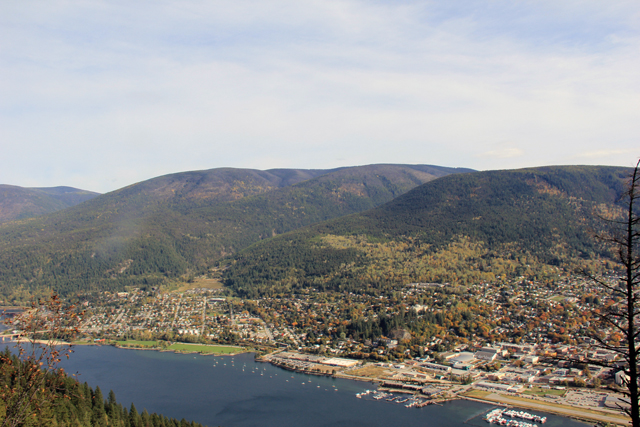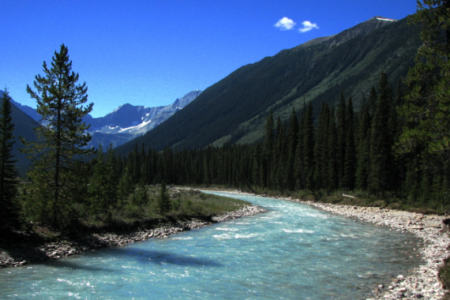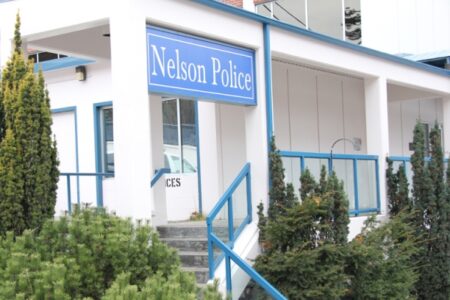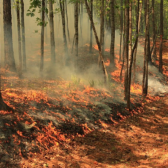Exemption granted to cut trees in forest above Nelson to reduce beetle, wildfire risk
A project to help lower the Douglas fir bark beetle population in the forest above Nelson and reduce the wildfire risk potential has given a local lumber company an exemption to cut trees in an otherwise restricted area.
Kalesnikoff Lumber Co. Ltd has had an exemption to a retention visual quality objective granted to it by the province for polygon 158 — directly above and to the southeast of Nelson — to allow the falling of Douglas fir trees through a Douglas fir bark beetle trap tree program, said Kalesnikoff spokesperson Tyler Hodgkinson.
“The exemption was granted as a Douglas fir bark beetle infestation has been identified and Kalesnikoff requires this to carry out a trap tree program to control the beetle population with hopes to lower the population,” he said.
The hillside above Nelson is primarily Douglas fir, Hodgkinson noted, so if the beetle was left unchecked more of the trees could become infested and die.
“This would increase the wildfire hazard adjacent to the city of Nelson and reduce opportunities to create shaded fuel breaks,” he said.
The exemption to cut trees only pertains to openings identified for the creation of trap trees, where each of the 17 openings will not exceed 0.5 hectares in size. Visual quality objectives (VQO) are defined in the Forest Planning and Practices Regulation to provide qualitative descriptions of expected visual conditions, said Hodgkinson.
“The hillside behind Nelson is in a retention VQO where alteration has to be difficult to see, small in scale and natural in appearance,” he said. “Since the hillside currently does not meet this definition any further alteration would not as well, hence the exemption.”
There has already been some forest logged above Nelson, completed in the past in collaboration with the regional district to reduce the wildfire risk to the city of Nelson. Using a similar exemption for polygon 158, the understanding at the time was the retention objective — visual appearance — would be achieved as the regenerated forest visually “greened up” (grew into a new forest).
Since polygon 158 still has a retention objective and has not visually greened, an exemption was required to carry out further alteration for the new project, said Hodgkinson.
The idea for the project began in 2016. Kalesnikoff staff was in the Selous forest above Nelson last summer looking at carrying out wildfire urban interface treatments in collaboration with the regional district, said Hodgkinson, when it was discovered the area had a significant beetle population that required control measures to be implemented.
Although the beetle’s impact is not serious nor is it a danger, Hodgkinson noted, if left unmanaged it could become a problem.
“(But) the RDCK and the City of Nelson are taking this very seriously,” he said. “Due to the importance of the Selous forest to the City of Nelson and Kalesnikoff, Kalesnikoff considers aggressive action should be taken and the (beetle) populations should not be overlooked.”
Douglas fir bark beetles are naturally always present in forests, Hodgkinson explained. Once a forest matures and culminates the beetle’s natural cycle is to infest the trees as they age and weaken, leading to a stand replacement fire (wildfire).
“I do not want to be an alarmist, but the (beetle) population needs to be dealt with in a timely manner or else it could grow into a problem that could increase the dead trees above Nelson and increase the high hazard of uncontrollable wildfire in our summer months,” Hodgkinson said.
The Douglas fir bark beetle is not like the mountain pine beetle as it prefers weakened trees and blowdown.
Primary management activity will be the use of small tree group treatments to lure and trap beetles during their annual flight, Hodgkinson explained. High amounts of moderate to highly susceptible stands remain with very small harvest disturbances and endemic beetle populations.
The felled trap trees must remain on site until August so the bark beetles will concentrate in the trap trees, rather than healthy standing ones.
“The trap trees are considered a suppression treatment, which maintains and expands on the capacity to aggressively monitor and manage (beetles) with the application of an annual trap tree program,” said Hodgkinson.
To prevent felled trees from being removed by firewood cutters, signage will be posted notifying people of the trap tree program.
Management strategy
The provincial government has recognized that bark beetles in general warrant a unique focus. As a result, the province has a bark beetle strategy with the following objectives:
- minimize the spread of beetles
- minimize the loss of timber value
- minimize the loss of Crown revenue
- protect communities from wildfire
To address these objectives the province supports aggressive management to stop further spread where it makes economic sense and is supported by sound forest management principles and stakeholder support (Ministry of Forests, 2003).
Typically a Douglas fir bark beetle management strategy involves an initial sanitation treatment followed by suppression and prevention treatments.
Sanitation treatments are utilized to address current beetle infestations by harvesting identified beetle centres while beetle proofing remaining areas.
Beetle proofing involves management actions that promote tree vigour while removing infected or susceptible trees. Beetle proofing reduces stand susceptibility; it does not make stands invulnerable to attack.
Suppression treatments are utilized where the majority of the beetle-infested timber has been removed leaving a beetle population at a level that can be dealt with through an annual trap tree program. The trap trees will be brought into the Kalesnikoff mill and milled.
“The suppression treatment for all intents and purposes can potentially reduce the beetle populations or help to keep the populations from increasing,” said Hodgkinson.
Source: Kalesnikoff Lumber
For more information:



























